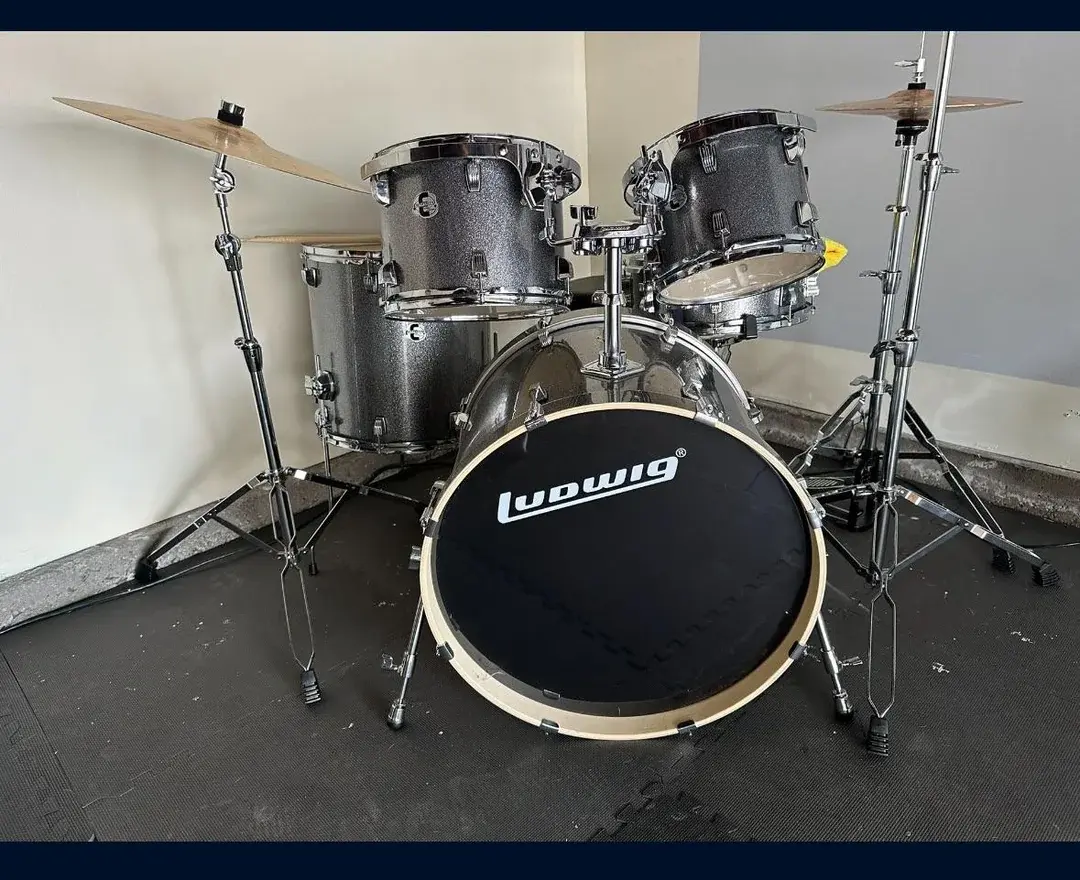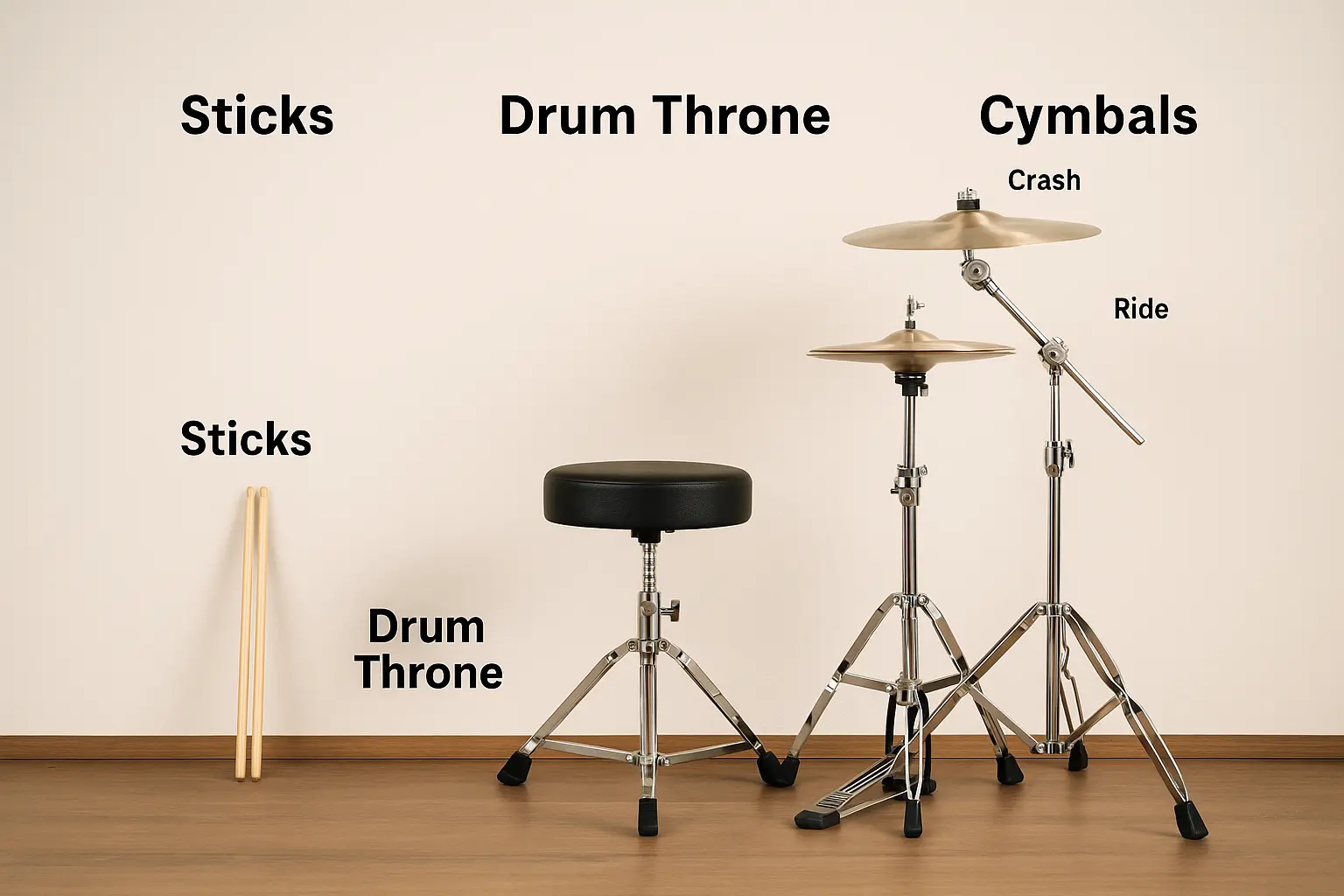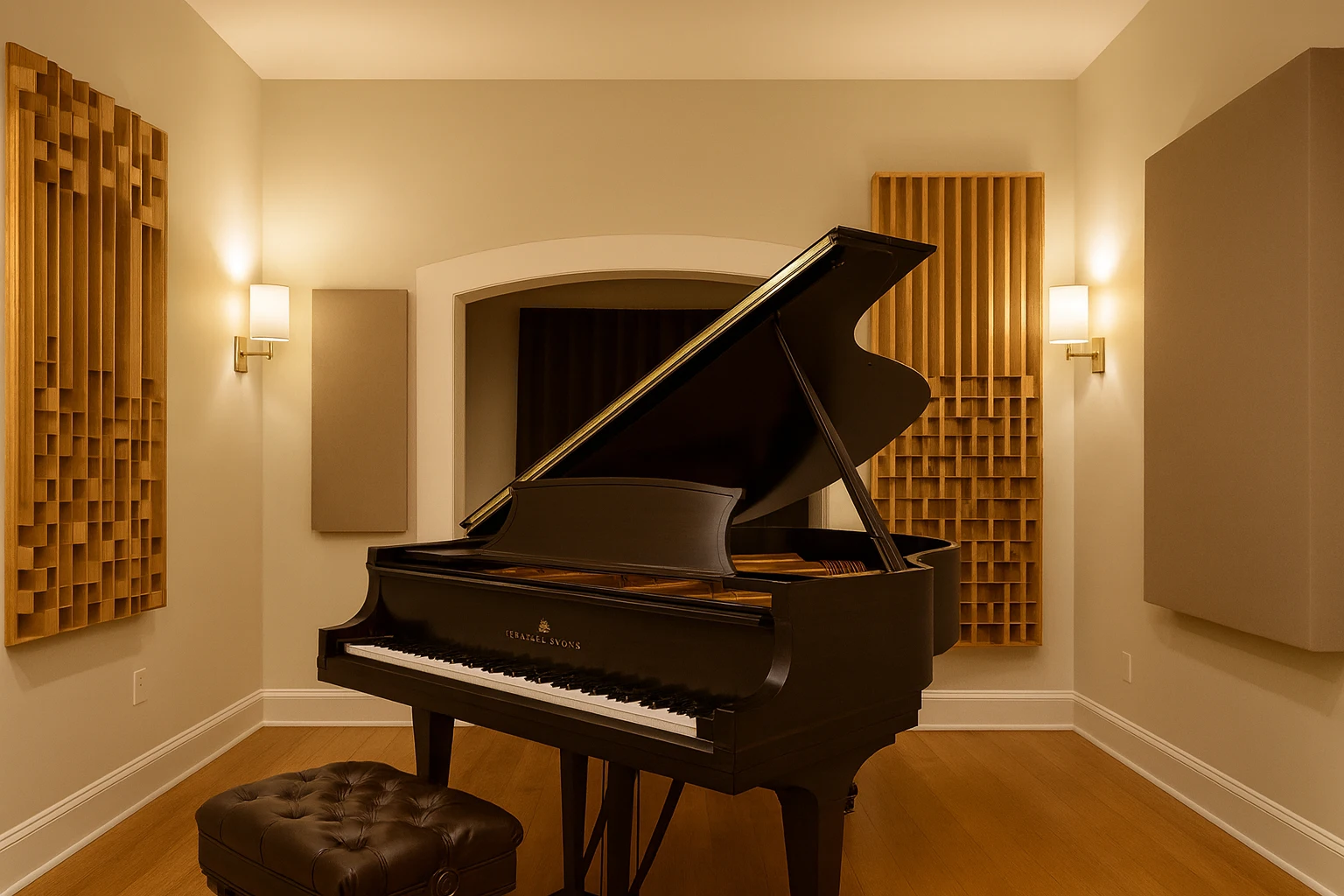You’ve been thinking about it for weeks. Maybe months. That itch to finally get behind a real drum set instead of tapping your fingers on the desk or your knees.
You picture yourself keeping time like a pro, the rhythm locking in, the sound filling the room. But then reality hits:
Where do you even start? What’s the difference between that shiny kit in the music store and the used one on Craigslist? And why are there so many kinds of cymbals?
Here’s the truth. Starting drums can feel like stepping into a foreign city without a map. That’s why I’m walking you through it like we’re in the same practice room, sticks in hand.
By the time we’re done here, you’ll understand every major part of a kit, how to choose one that fits you, and how to start without annoying your neighbors or blowing your budget.
What Is a Drum Set?
Getting familiar with the drum set components is your first step. A standard drum set typically includes a bass drum (the big one you hit with a foot pedal), a snare drum (the sharp, high-pitched drum in front of you), one or more tom-toms (for fills and variations), and a set of cymbals.
Importantly, that pair of cymbals on a drum set you’ve likely noticed is called the hi-hat. The hi-hat is two cymbals mounted on a stand, controlled by a foot pedal to open and close them. You’ll often play steady rhythms on the hi-hat with your stick (while using the pedal with your foot).
Other cymbals include the crash (for accents) and ride (for steady patterns), but don’t worry about those right now. Just focus on the hi-hat and a single crash to start.
You can go deeper into cymbals later, crash for big accents, ride for steady patterns, but for now, just know this: a basic setup with bass drum, snare drum, two toms, a floor tom, hi-hat, and one crash/ride is plenty to get started.
Quick Tip: Don’t stress over having every drum. You don’t need a 12-piece stadium kit to sound like a drummer. Learn to play drums on a basic 5-piece kit (bass, snare, 2 toms, floor tom) with a hi-hat, ride, and one crash cymbal is plenty to start learning. More gear can always come later.
Choosing Your First Drum Kit (Ludwig vs Pearl vs Tama)
This is where most beginners overthink things. The truth? You don’t need the perfect kit to start; you just need one that’s playable, sturdy, and inspires you to sit down and practice.
Let’s talk about three big names you’ll hear a lot:
- Ludwig drums – If you’ve seen Ringo Starr’s famous black oyster pearl kit on the Ed Sullivan Show, you’ve seen Ludwig. They’re known for their warm, classic tone and snare drums that are still recording studio royalty. For beginners, their Element Evolution series is solid and affordable.

- Pearl drums – Reliable, well-built, and everywhere. The Pearl Export is basically the Toyota Corolla of drum sets: not flashy, but dependable and lasts forever. Their Roadshow kits are a great entry point, and you can upgrade piece by piece later.
- Tama drums – If Ludwig is classic rock and Pearl is all-around dependable, Tama is pure punch and durability. Their Imperialstar kits are perfect for beginners who want something that can take a beating and still sound good.
Here’s my take: try a few in person if you can. Feel how the pedals respond. Hear the tone of the toms. In Los Angeles, we often recommend that beginners check local music stores for used kits. You can find great deals and avoid the shipping costs.
What Drums Do I Buy? Cheap vs Expensive
This is the question every beginner (and parent) asks. Go too cheap, and you’ll outgrow the kit in a year and end up reinvesting.
Going too expensive, and you risk wasting money if the student loses interest. The smart move is to aim for the middle of the line. Kits in this range can last a decade or more with proper care, and they hold resale value if you ever upgrade.
As a rule of thumb: $500 is a solid beginner budget, whether you choose acoustic or electronic. At that price point, you’ll get a kit that sounds good, feels reliable, and won’t fall apart in six months.
And if you’re not ready to commit, start with a used set, learn your basics, then upgrade when you know exactly what you want.
Do I Buy An Acoustic or an Electronic Drum Kit?
If noise isn’t an issue and you want the most authentic feel, buy an acoustic kit. If you live in an apartment, have parents/neighbors to consider, or want built-in practice tools, go electronic. Both will teach you the same fundamentals.
Acoustic Kits (Best for Space & Feel)
If you’ve got the space and noise is not a problem, acoustic kits are still the gold standard. They give you the most natural rebound, dynamic range, and that live “kick in the chest” sound. Most major drum brands (Ludwig, Pearl, Tama, Yamaha, Mapex) offer beginner, midline, and pro-level kits.
- Pearl Roadshow – full starter kit with cymbals and hardware included.
- Ludwig Questlove Pocket Kit – compact, beginner-friendly kit designed with Questlove.
- Pearl Export – legendary entry-level pro kit, durable and versatile.
- Tama Imperialstar – reliable all-around kit with great tone for the price.
- Ludwig Element Evolution – comes complete with Zildjian cymbals, ready to play out of the box.
- Mapex Mars – punchy maple shells with pro-style hardware at a midline price.
- Yamaha Stage Custom Birch – birch shells delivering bright, articulate tone for gigging drummers.
- DW Design Series – premium build quality with professional studio sound.
Pro tip: If you need quieter practice, consider adding low-volume cymbals (Zildjian L80, Sabian Quiet Tone) or mesh drum heads. They cut volume by up to 80% while keeping the feel of an acoustic kit.
Electronic Kits (Best for Apartments & Parents)
For most beginners living at home or in cities like Los Angeles, electronic kits are a lifesaver. You can plug in headphones, practice all night, and never get a noise complaint. Modern e-kits also come with built-in coaching tools, metronomes, and play-along tracks.
And yes, training on an electronic kit still translates to acoustic drums. The feel is slightly different, but the fundamentals are the same.
- Entry-level (<$400): Alesis Nitro Mesh, Roland TD-1K. Good for kids starting out, but limited in realism.
- Midline ($500–$900): Roland TD-07KV, Alesis Surge Mesh, Yamaha DTX6K-X. These balance feel, durability, and features.
- High-end ($1,200+): Roland V-Drums Series, Yamaha DTX10 series. Incredible realism, but overkill unless you’re recording or pro-level.
Quick Comparison
Bottom line: let the student choose. If they’re excited about the sound and look of an acoustic kit, great. If quiet practice is the priority, go electronic. Either way, a $500 budget gets you a kit that sounds good, lasts long, and won’t hold back progress.
Want to skip the trial-and-error and start sounding great faster? At Angeles Academy of Music, we’ve been helping Los Angeles drummers build solid technique and confidence from day one. Try a free introductory lesson and get personalized guidance on your first kit, posture, and beats. Book your free drum lesson here.
Essential Drum Gear: Sticks, Drum Throne, and Cymbals
You’ve got your kit in mind. Now let’s talk about the stuff that actually makes it playable and comfortable.

Drumsticks
Think of sticks like shoes: wrong size, wrong feel, and you’re going to hate walking in them. The most popular size is the 5A, the Goldilocks option. Not too heavy, not too light. Great for rock, pop, funk, whatever you’re into. If you want lighter and faster, try a 7A. If you want heavier and louder, look at a 5B or even a 2B.
Drum throne
Your throne isn’t just a seat. It’s your foundation. Set it so your knees are at roughly a 90-degree angle when your feet are on the pedals. Too high and you’ll lose power. Too low and you’ll put strain on your back and knees. Good posture from day one means you’ll be able to play longer without feeling like you’ve just finished a squat workout.
Cymbals
We already covered that pair of cymbals on a drum set: your hi-hat. You’ll also want at least one crash cymbal (for accents) and a ride cymbal (for steady patterns). If you’re buying a starter kit, it may come with beginner cymbals.
Great starter cymbal packs:
- Zildjian Planet Z Complete Pack (14"/16"/20") – affordable entry-level set that covers all bases.
- Sabian SBR Performance Set (14"/16"/20" + free 10" splash) – brass beginner pack with solid durability and a bright tone.
- Meinl HCS Basic 4-Piece Pack (14" hats / 16" crash / 20" ride + 10" splash) – popular beginner option; includes an extra splash cymbal.
- Zildjian I Series Standard Gig Pack (14"/16"/20") – step up from the Planet Z; warmer sound and better balance.
Need to keep it quiet? Check out these low-volume cymbal packs:
- Zildjian L80 Low Volume LV468 (14"/16"/20") – cuts sound by up to 80% while keeping natural feel.
They’re fine for learning, but when you upgrade, look at Zildjian, Sabian, or Meinl. All drum lessons for all levels start with these basics.
The Snare Drum: Your Main Voice
If the bass drum is your heartbeat, the snare drum is your personality. It’s that sharp, cracking sound you hear on every backbeat. The snare wires under the bottom head give it that snap. Keep it tuned tight enough for clarity, but not so much that it sounds like you’re hitting a tin can.
Fun fact: Some drummers collect snares like sneakers. They change them out depending on the song or mood. But as a beginner, you don’t need a closet full of snares. You can get a surprising variety of sounds just by tuning a single snare differently.
Looser tension gives you a fat, deep crack; tighter tension gives you a bright pop. Experiment before you spend.
The Bass Drum: Driving the Beat
The bass drum (or drum bass drum) is the big, low boom that drives the music forward. You’ll play it with a foot pedal, and you’ll quickly learn that how you attack it changes everything. Heel-down for control. Heel-up for power. Play around with both.
Pro tip: If you’re practicing at home, put a pillow or small blanket inside the drum to muffle it. You’ll get a punchy thump instead of a long, resonant boom that wakes up the whole block.
Drum Machines for Practice and Creativity
A drum machine isn’t just for electronic music producers. It’s your best friend for practicing timing. Think of it as a metronome with personality. You can program beats, loop them, and play along. Brands like Roland and Alesis make great beginner-friendly models.
Here’s a trick: set a simple groove on your drum machine and play along until it feels boring. Then start adding your own fills. That’s when you know you’re locking into the pocket.
Steel Drum Instruments: A Different Flavor
Not all drums are part of a kit. A steel drum instrument is a melodic percussion instrument from the Caribbean, made from a metal barrel. Instead of providing rhythm only, it plays notes. It’s completely different from a standard drum set, but worth mentioning because it shows just how wide the drumming world really is.
And beyond kits and steel pans, the world of drums is massive. Think congas, bongos, and cajóns, hand-played drums that bring Latin, Afro-Cuban, and flamenco grooves to life. Or smaller percussive elements like shakers, tambourines, and cowbells, which may look simple but can completely change a song’s feel. These instruments aren’t just add-ons. They teach you dynamics, touch, and timing in ways a full kit can’t. Exploring them expands your rhythm vocabulary and makes you a more well-rounded drummer.
Practicing in a Small Space or Apartment
If you live in Los Angeles, you probably don’t have a basement to shake with your practice sessions. But that doesn’t mean you can’t play daily. Here’s how to keep the peace with your neighbors:
- Mute pads – Rubber or mesh covers for your drums and cymbals that cut volume by more than half.
- Low-volume cymbals – Specially perforated cymbals that keep the feel but reduce the sound (Zildjian L80s are a favorite).
- Electronic kits – Mesh-head e-kits let you practice with headphones and barely make a sound.
- Old-school hacks – Towels over the drums. Lighter sticks. Even a practice pad for just working on your snare technique.
It’s all about consistency. You’re better off practicing quietly every day than playing loudly once a week.
Stick Sizing and Choosing Drumsticks
If you’ve ever walked into a music store and stared at the wall of sticks, you know it can feel like picking a wand in Harry Potter. But here’s the thing. You really only need to start with one pair: 5A. Medium weight, good balance, works for almost everything.
If you’ve got lighter hands or want a more delicate feel (jazz, soft rock), try 7A. If you’re aiming for big, loud, rock energy, a 5B or even a 2B will give you more mass behind the hit. Remember: smaller numbers = thicker sticks.
Wood type matters too. Hickory is the classic “just right” option for most beginners. Maple is lighter, oak is heavier. But at this stage, don’t overthink it. Get one pair, wear them out, and you’ll naturally figure out what feels best.
Frequently Asked Questions
How much drumming experience do I need?
Zero. None. Nada. Every drummer you’ve ever heard started at the same place you are, trying to make sense of how to hit a hi-hat, snare, and bass drum without your limbs rebelling.
I’m overwhelmed by all the gear. Where do I even start?
One kit. One good pair of sticks. That’s it. Forget the shiny add-ons until you’re comfortable playing a basic beat. You can always upgrade, and trust me, you will, but first, get the fundamentals down.
My drums are way too loud for my apartment. What now?
Low-volume cymbals, mute pads, or an electronic kit. Or just a practice pad if that’s all you can manage for now. Playing quietly beats not playing at all.
How long until I can play a full song?
Some people manage in a month. Others take a few. The real question is: are you practicing regularly? Ten minutes a day beats two hours once a week. Some gifted students also learn on the first day itself and make progress faster.
Am I too old to start?
Nope. Drums don’t care how many birthdays you’ve had. At our school, we’ve had beginners in their 60s and 70s who can groove better than teenagers.
Staying Motivated When It Gets Hard
Some days, you’ll feel like you’re nailing it. Other days, you’ll swear you’ve never had rhythm in your life. That’s normal. Don’t bail when it gets messy. That’s where growth happens.
Break your goals down into bite-sized wins: nail one fill this week, keep a steady beat for three minutes without drifting, play along to one full song without stopping. Small wins add up fast.
And don’t isolate yourself. Play with friends, jam with a guitarist, or join a beginner band class here at Angeles Academy of Music. Drumming is more fun and motivating when it’s shared.
Why Lessons at Angeles Academy of Music Make a Difference
Yes, you could learn drums from YouTube videos, and you’ll probably make progress. But here’s the catch: no one’s there to stop you when you’re developing bad habits. That’s where we come in.
We’ve been teaching in Los Angeles for years. We’ve seen every beginner struggle, from “I can’t coordinate my limbs” to “My snare sounds like a trash can.” And we know how to fix them, fast.
Having an actual in-person teacher also means your lessons are matched to you. YouTube is broad, one-size-fits-all. But every student learns differently. Some are visual, some auditory, some like step-by-step written instructions. A teacher can adapt instantly, explain in a way that clicks for you, and fast-forward your progress by months (sometimes years).
Lessons here are tailored to your goals, your music taste, and your schedule. You’ll learn technique, posture, timing, and how to make practice actually feel enjoyable.
Ready to Start?
The drum set is sitting there, waiting for you to take the first swing. You don’t need to feel ready. You just need to start.
We offer free introductory lessons so you can get behind a kit and feel what it’s like with a teacher guiding you. Click here to book your spot.
Because here’s the truth: the only difference between you and the drummer you admire… is that they picked up the sticks one day and didn’t put them down.
The only thing between you and your first drum groove is a pair of sticks and the decision to start. Angeles Academy of Music offers private and online drum lessons for all levels, taught by experienced LA drummers who know how to make learning fun and effective. Don’t wait for ‘someday’. Schedule your first lesson and start playing the drum set today.
Contributed by: Jonathan B., Senior Percussion Instructor at Angeles Academy of Music (Bachelors of Music, Musicians Institute; Associate of Arts, Suffolk College.)
.svg)
.svg)
.svg)
.svg)
.svg)
.svg)





.svg)